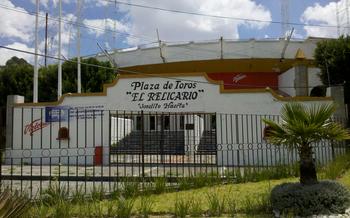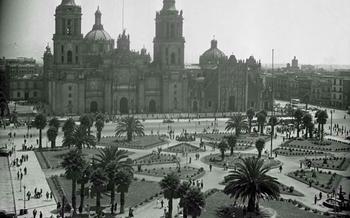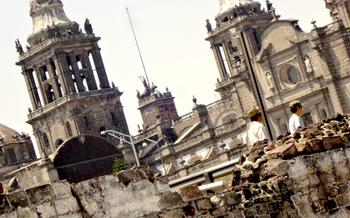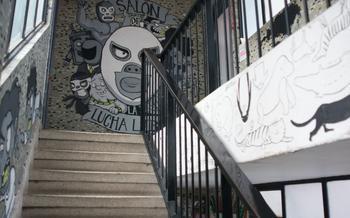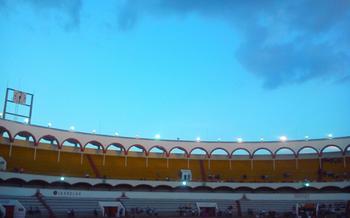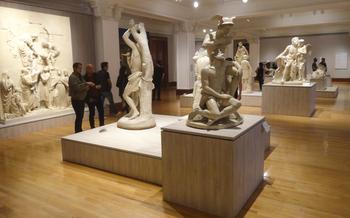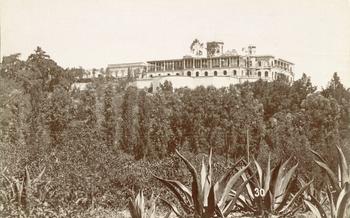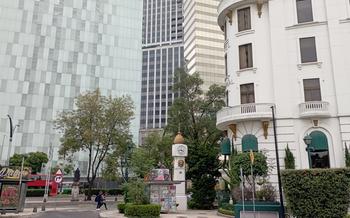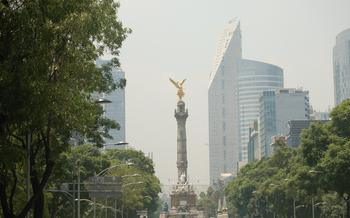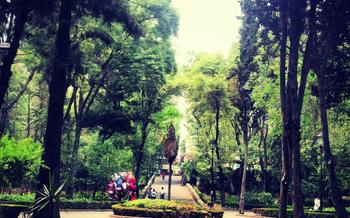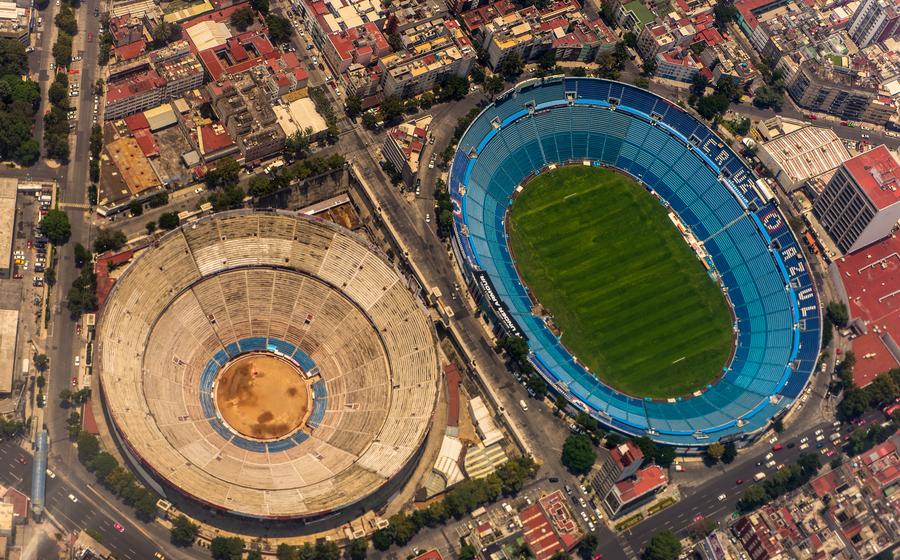
Plaza de Toros México
- Plaza de Toros México: An Architectural Masterpiece
- Events and Performances at the Plaza
- Exploring the Plaza's Surroundings
- Understanding the Controversy Surrounding Bullfighting
- Famous Bullfighters and Their Legacies
- The Bull's Role in the Spectacle
- Safety Measures and Regulations
- Bullfight Etiquette and Dress Code
- Exploring the Bullfighting Museum
- Local Cuisine and Dining Options
- Insider Tip: Unique Photo Opportunities
Plaza de Toros México: An Architectural Masterpiece
The Plaza de Toros México, also known as La Monumental, is an iconic landmark in Mexico City and a testament to the country's rich cultural heritage. Inaugurated in 1946, this colossal bullring holds the distinction of being the largest bullfighting venue in the world, capable of accommodating over 40,000 spectators. Its unique architectural features, blending Moorish and Art Deco styles, make it a masterpiece of 20th-century architecture.
La Monumental's historical significance is intertwined with Mexico's bullfighting tradition, dating back to the colonial era. The bullring has witnessed countless thrilling bullfights, showcasing the skills and artistry of legendary matadors. Beyond its sporting significance, the Plaza de Toros México has become a symbol of Mexican culture and identity, representing a blend of tradition, spectacle, and national pride.
Events and Performances at the Plaza
The Plaza de Toros México is renowned for its bullfights, which take place every Sunday during the bullfighting season, typically from November to March. The season is divided into two parts: the temporada grande (main season) and the temporada chica (minor season). Tickets can be purchased online or at the box office, with prices varying depending on the seat category. The tendidos (lower-level seats) offer a closer view of the action, while the palcos (private boxes) provide a more exclusive experience.
Beyond bullfights, the Plaza also hosts a variety of other events, including concerts, sporting events, and cultural shows. These events attract a diverse audience and showcase the versatility of this iconic venue. For non-bullfight fans, these alternative events offer an opportunity to experience the Plaza's grandeur without witnessing the controversial spectacle.
Insider's tip: If you're visiting Mexico City during the off-season, you can still enjoy the Plaza's beauty by taking a guided tour. These tours provide an in-depth look at the bullring's history, architecture, and cultural significance.
Exploring the Plaza's Surroundings
Beyond the bullfighting arena, the Plaza de Toros México is surrounded by a vibrant neighborhood teeming with attractions and activities. Chapultepec Park, a sprawling urban oasis, is just a stone's throw away, offering a welcome respite from the city's hustle and bustle. With its lush gardens, tranquil lakes, and iconic castle, the park is a popular destination for locals and tourists alike.
For those seeking a lively nightlife scene, the Zona Rosa, situated a short walk from the Plaza, beckons with its trendy bars, nightclubs, and restaurants. This vibrant district is renowned for its cosmopolitan atmosphere and diverse offerings, catering to every taste and preference.
Transportation to and from the Plaza is a breeze, with the Metro and bus lines providing convenient connections. Taxis are also readily available, offering a comfortable and direct mode of transport.
Safety is a paramount concern for travelers, and the area surrounding the Plaza is generally considered to be safe. However, as with any major city, it is advisable to exercise caution and be aware of your surroundings, particularly at night.
Insider's Tip: Venture beyond the immediate vicinity of the Plaza to discover hidden gems and local favorites. Explore the side streets and alleys, where you'll find charming cafes, unique boutiques, and authentic Mexican restaurants frequented by locals.
Understanding the Controversy Surrounding Bullfighting
Bullfighting, as an age-old tradition, has been met with growing scrutiny and controversy in recent times.
Famous Bullfighters and Their Legacies
Over the centuries, the world of bullfighting has been adorned by legendary matadors whose skill, bravery, and charisma have left an indelible mark on Mexican culture and society. Among the most renowned names are:
-
El Cordobés: Born Manuel Benítez Pérez, El Cordobés is considered one of the most influential bullfighters of all time. Known for his innovative techniques and crowd-pleasing style, he revolutionized the art of bullfighting and gained immense popularity during the 1960s and 1970s.
-
Manolete: Widely regarded as one of the greatest bullfighters in history, Manolete, whose real name was Manuel Laureano Rodríguez Sánchez, was known for his exceptional technique, elegance, and courage in the ring. His tragic death in 1947 at the age of 30 cemented his status as a legend.
-
Luis Miguel Dominguín: A contemporary of Manolete, Luis Miguel Dominguín was another iconic matador who captivated audiences with his daring and flamboyant style. He was known for his rivalries with Manolete and El Cordobés, adding to the allure and drama of the bullfighting world.
These legendary matadors, along with many others, have left a lasting legacy in Mexico, inspiring generations of aspiring bullfighters and contributing to the rich cultural tapestry of the country. Their names and achievements are synonymous with the art of bullfighting and continue to be celebrated and revered by aficionados worldwide.
The Bull's Role in the Spectacle
For centuries, bulls have played a crucial role in the spectacle of bullfighting. Traditionally, bulls used in bullfights are specifically bred for their strength, agility, and temperament. Ranchers meticulously select and train these animals, ensuring they possess the desired characteristics for the ring.
During a bullfight, the bull's behavior and instincts are crucial to the performance. The animal's natural aggression and unpredictability add an element of danger and excitement to the event. The bull's strength is evident as it charges at the matador, while its agility allows it to evade and maneuver during the fight.
Witnessing the bull's power and grace firsthand is a remarkable experience. The animal's determination to defend itself and its ability to turn the tables on its opponents create moments of both awe and apprehension. The bull's role in bullfighting is integral to the spectacle's drama and intensity.
Safety Measures and Regulations
The Plaza de Toros México prioritizes the safety of both matadors and bulls. Matadors wear protective gear, including a suit of lights (traje de luces), a montera (hat), and a coleta (pigtail). Assistants, such as banderilleros and picadors, also wear protective clothing. Veterinary care is provided for injured bulls, and there are strict regulations in place to ensure their well-being.
Despite these measures, bullfighting remains a controversial sport due to concerns about animal cruelty. Animal rights activists argue that the bulls are subjected to unnecessary pain and suffering. However, proponents of bullfighting maintain that the bulls are treated humanely and that the sport is a cultural tradition that should be preserved.
Personally, I believe that the safety of both matadors and bulls is of paramount importance. While I respect the cultural significance of bullfighting, I also recognize the ethical concerns surrounding the treatment of animals. It is important to strike a balance between preserving tradition and ensuring the welfare of all involved.
Bullfight Etiquette and Dress Code
Attending a bullfight in Mexico City is a unique cultural experience that comes with its own set of etiquette and dress code. While there are no strict rules, following certain guidelines ensures a respectful and enjoyable experience for all.
For attire, dress elegantly and conservatively. Men typically wear a suit or smart casual attire, while women can opt for a dress, skirt, or pantsuit. Avoid wearing shorts, tank tops, or overly revealing clothing.
During the bullfight, maintain respectful behavior. Applaud good performances and showmanship, but refrain from jeering or booing. It is customary to rise from your seat when the matador enters the ring and when the bull is killed.
Some taboos and faux pas to avoid include talking loudly, using your phone during the fight, or heckling the matadors or bulls. Refrain from throwing objects into the ring or making disruptive noises.
My first time attending a bullfight, I opted for a classic black dress and a light scarf. I wanted to show respect for the tradition while still feeling comfortable and stylish. The atmosphere was electric, and I couldn't help but feel a sense of awe and excitement as I witnessed the spectacle unfold before me.
Exploring the Bullfighting Museum
Located within the Plaza de Toros México, the Bullfighting Museum offers a fascinating glimpse into the history and traditions of bullfighting in Mexico. With its impressive collection of artifacts and interactive displays, the museum provides a comprehensive overview of this controversial yet iconic part of Mexican culture.
Visitors can learn about the origins and evolution of bullfighting in Spain and its introduction to Mexico in the 16th century. The museum showcases a wide range of exhibits, including vintage posters, bullfighting suits, and weapons used by matadors throughout history. Interactive displays allow visitors to experience the thrill of a bullfight from the perspective of a matador, simulating the movements and techniques involved.
Educational programs and guided tours are available for those seeking a deeper understanding of bullfighting. The museum also hosts temporary exhibitions and events, offering a dynamic and engaging experience for visitors of all ages.
Local Cuisine and Dining Options
A visit to the Plaza de Toros México is not complete without savoring the delicious local cuisine. The surrounding area offers a diverse range of dining options, from traditional Mexican restaurants to street food vendors. Indulge in the rich flavors of tacos, enchiladas, tamales, and pozole. Be sure to try the famous "tacos al pastor," a specialty of Mexico City, featuring succulent pork marinated in achiote sauce and grilled on a vertical spit. For a unique culinary experience, explore the nearby Mercado de San Juan, a bustling market offering an array of fresh ingredients, exotic spices, and ready-to-eat delicacies. Don't miss the chance to sample the sweet and tangy "esquites," a popular snack made with grilled corn, mayonnaise, and cotija cheese. Whether you prefer a sit-down meal or a quick bite on the go, the area surrounding the Plaza de Toros México has something to satisfy every palate.
Insider Tip: Unique Photo Opportunities
The Plaza de Toros México is a visually stunning landmark that offers endless photo opportunities. Capture the grandeur of the exterior facade with its intricate Moorish-style arches and vibrant colors. Step inside to capture the vastness of the arena, with its rows of colorful seats and the iconic sand-covered ring.
For a unique perspective, head to the upper levels of the bullring to capture panoramic shots of the entire Plaza. Don't miss the opportunity to photograph the matadors during the paseíllo, as they parade around the ring in their elaborate costumes.
Remember to be respectful of the ongoing events and avoid using flash photography during bullfights. Embrace the vibrant atmosphere, capture the emotions of the crowd, and share your unique perspective of this iconic landmark with the world.
